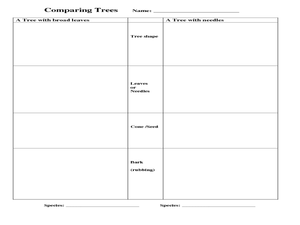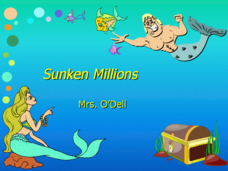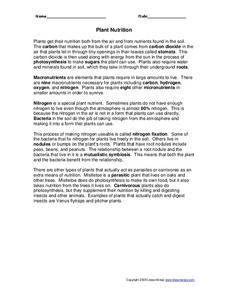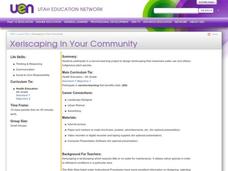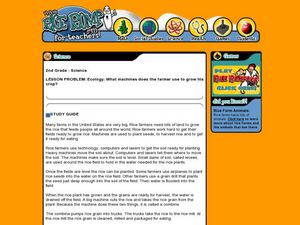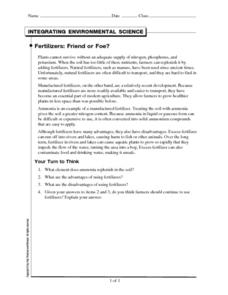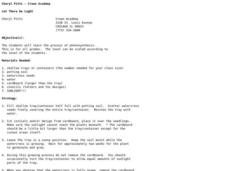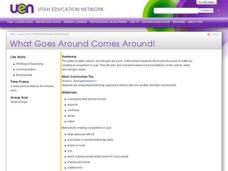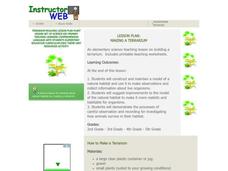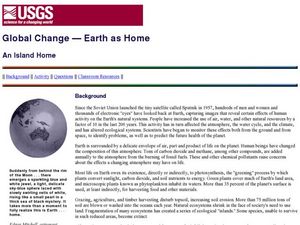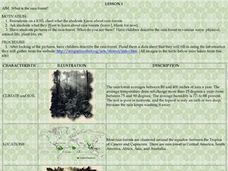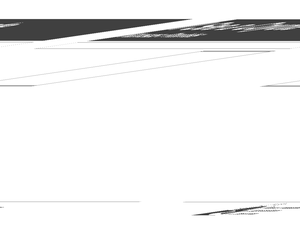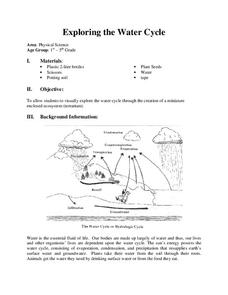Curated OER
Acid Rain
In this acid rain worksheet, students review the causes of acid rain and the effects of acid rain. This worksheet has 19 fill in the blank questions.
Curated OER
Sorting
Pupils identify how objects can be sorted or classified for easy access. In this sorting activity, students will investigate how letters, numbers, and symbols are used in sorting and classifying.
Curated OER
Temperate Forest: Comparing Deciduous and Evergreen Trees
Students compare deciduous and evergreen trees. In this tree lesson, students list the differences between these two species of trees.
Curated OER
Sunken Millions
This PowerPoint provides a game show format with multiple choice questions about fresh and salt water. Topics include sources of water, water geography, uses of water, and the water cycle.
Curated OER
Genetically Modified Foods
Students explain what genetically modified foods are and how they are created. Students use appropriate vocabulary to describe and effectively discuss the benefits of, and potential risks of, genetically modified foods.
Curated OER
The Life of Fungi
In this fungi worksheet, students will read about the three different ways that fungi get their food; decomposers, parasites, and mutualists. Then students will match three statements with the diagrams that fit the description.
Curated OER
Decomposers- Nurse Logs
Students investigate temperate forest ecosystems. In this environmental lesson, students discover different forms of decomposition and its effect on the environment.
Curated OER
Those Amazing Earthworms- A Worm's World
Students investigate earthworms. In this organisms lesson, students observe earthworms in their environment and record their behavior towards light and how they eat. Students continue on a month long observation.
Curated OER
Plant Nutrition
For this plant nutrition worksheet, students read for information and assess comprehension. In this true and false, fill in the blank, multiple choice, and short answer worksheet, students answer ten questions.
Curated OER
Rock Cycles, Crayon Cycles
Students examine the rock cycle and the path that rocks go through to rearranged in different ways. They define key vocabulary terms, then in small groups conduct a variety of experiments using crayon shavings as simulated rocks and...
Curated OER
Seed Socks
Learners explore how seeds travel. In this seed disbursement lesson, students head outside in their bare socks. Learners walk around then before going inside they take the socks off and examine what their socks picked up. As a class the...
Curated OER
Xeriscaping In Your Community
Fourth graders participate in a service-learning project. They design landscaping that maximizes water use and utilizes indigenous plant species. Afterward, they advertise and present their xeriscape garden at a school function such as...
Curated OER
Machines Rice Farmers Use
Second graders investigate rice farming. In this farming equipment lesson, 2nd graders discover what type of equipment is needed to get rice farms ready to plant. Students gain knowledge about what a combine does and how it is important...
Curated OER
Salt Marsh in a Pan
Students create a model of a salt marsh to discover the impact of pollution and human activities on water-based habitats including bays and the ocean. They recognize the relationship between natural and developed areas. Students impact...
Curated OER
Fertilizers: Friend or Foe?
In this fertilizer worksheet, learners read about natural and manufactured fertilizers. They answer four critical thinking questions about fertilizers and their use.
Curated OER
Let There Be Light
Students plant seeds and learn about photosynthesis. In this photosynthesis instructional activity, students plant watercress seeds, cut a design into cardboard and cover the seedlings with the cardboard. Students observe as...
Curated OER
Ecology
In this ecology instructional activity students complete a crossword puzzle that incorporates all of the ecological vocabulary in the word puzzle.
Curated OER
Explore Your Natural Habitat
Students identify habitats and understand why they are important to our environment. In this environmental lesson students design their own habitat, observe and record data on the impact their habitat has on the environment.
Curated OER
What Goes Around Comes Around!
Students create an ecosystem in a jar to show a model of the water, carbon, and nitrogen cycle. Working in small groups, they research and present orally the information they find on this cycle.
Curated OER
Making a Terrarium
Students construct and maintain model of natural habitat, suggest improvements to the model of the natural habitat to make it more realistic and habitable, and demonstrate careful observation and recording of how animals survive in their...
Curated OER
Global Change- Earth as Home
Students create their own environment. In this environmental protection instructional activity, students pretend they are the owners of a tropical island. They create jobs for the citizens and develop the island as a model environment.
Curated OER
What is the Rainforest?
Students investigate rainforests. In this rainforest lesson, students brainstorm on a KWL chart about what they already know about the rain forest. Students are shown pictures of the rain forest and describe what they see in the photos....
Curated OER
I See a Coyote
Students role-play coyotes looking for natural resources. In this natural resources lesson, students examine the relationship between animal life and the environment. Students play a game that demonstrates how natural...
Curated OER
Exploring the Water Cycle
Students investigate the water cycle. In this water cycle lesson, students create an ecosystem within a 2-liter bottle. Students record scientific observations as they observe the water cycle within their ecosystem.


